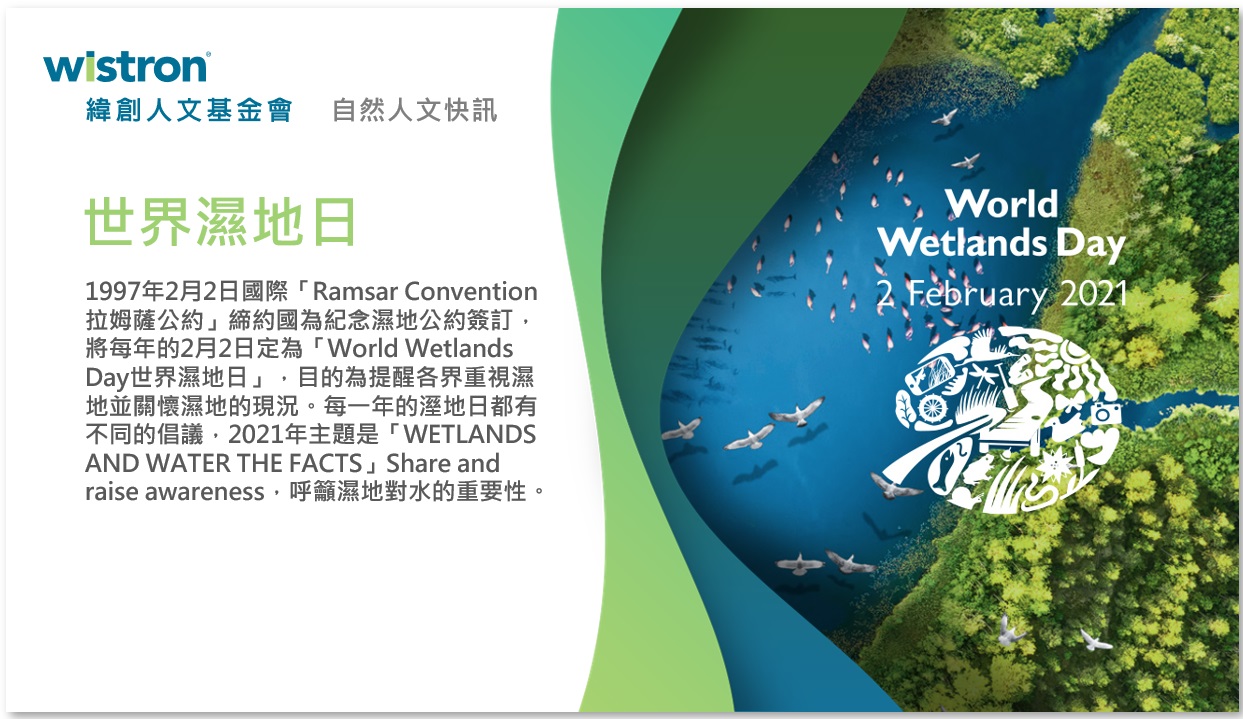
The precious wetlands of Taiwan - The beauty and sorrow of wetlands Author: Zhuang Yu-Wei (Society of Wilderness lecturer)
Wetlands can be referred to as to the kidneys of the Earth. But in reality, they have tremendous value in terms of the ecological balance of the Earth, tourism and recreation, ecological disaster prevention, pollution cleansing, habitats for wildlife, and the maintenance of food sources closely related to human life. Therefore, wetlands protection has been an international goal for many years.
Taiwan contains many wetland ecosystems and these are closely tied to life. Some tourist attractions include wetland parks near cities (e.g. Guandu, Niaosong, and Chengqing Lake), mangrove conservation areas, bodies of water in mountainous regions (e.g. Menghuan Lake, Sun Moon Lake, and various reservoirs), coastal attractions and water recreation zones (e.g. Qixingtan Beach, Xiangshan Coast, Qigu Salt Flats, Kenting, and northeastern tide pools), offshore island ecosystems (e.g. Orchid Island, Green Island, and Liuqiu Island), and many more gorgeous scenic areas of which you may be familiar.
In addition to tourist attractions, in terms of food in Taiwan, the Taiwan's staple food-rice producing areas, the water caltrop producing area of Guantian, the water lotus producing area of Meinong, the water bamboo producing areas of Puli and Sanzhi, various aquatic farming areas, nearshore fisheries, and tourist attractions (e.g. Brown Avenue in Chishang, Taitung), even popular bird watching spots near estuaries, swamps, and rivers and the “Datan Algal Reef”, known for the CPC natural gas project, are classified as wetlands.
Wetlands
So, what are wetlands? What is the definition? In fact, a broad definition was given when various nations signed the Ramsar Convention in 1971. Wetlands refer to “a permanent or temporary swamp, wet plain, bog, or aquatic area that is either natural or artificial, which contains static or flowing fresh water, semi-salt water, or salt water that does not exceed 6 meters in depth during low tides.”
This definition based on “area” does not view water and land as separate areas. The definition uses a more comprehensive perspective to protect and manage the environmental factors within the wetlands, such as “aquatic birds and accompanying organisms, water quality, soil and the terrain, and even human activities,” in order to ensure that the quality of the wetlands is sufficient to maintain the normal functions of the wetlands’ ecology. This is not accomplished by simply selecting and marking an area as a protected area.
Ramsar Convention
The convention was the first internal convention for wetlands protection. On February 2, 1971, various nations signed the convention in Ramsar, Iran. Therefore, the convention was named the Ramsar Convention. The full name of the convention is the Convention of Wetlands of International Importance Especially as Waterfowl Habitats. Nations hope to protect and reasonably use wetlands through international cooperation because damage to the environment is not limited by borders. The convention became effective on December 21, 1975. Started by 18 countries, 168 countries have now signed the convention. In order to commemorate the signing of the convention, the date of signing, February 2 has now been named World Wetlands Day.
The sorrows of wetlands
Wetlands are mostly bodies of water or low, easily flooded environments. Taiwanese society was deeply dependent on the natural environment back in the days when traditional agriculture and fishing accounted for a higher proportion of Taiwan’s industries. The majority of food and drinking water was obtained from the surrounding lands. However, perhaps due to the less common ideas of environmental pollution and environmental protection and the bigger focus on maintaining the productivity of the natural environment in the past, actions that pollute the environment were less common compared to today, since the land was the provider of food for the people.
As society changed, the industrial environment changed with it. With the addition of shrinking traditional aquaculture and farming industries caused by an aging population, large expanses of agricultural lands have gradually been replaced by factories, commercial buildings, and residential buildings. These changes, combined with the shortage of land in Taiwan, have caused natural environments (including wetlands) in Taiwan to gradually disappear.
We know that in Taiwan, the geographical features, such as tall mountains and rivers, have created a multitude of habitats and high biodiversity in terms of ecology resulting in the higher proportion of unique organisms in Taiwan compared to many other regions. However, the changes in political and economic activities and market demands have caused great changes to the ways land is used. In addition to ecology, this has affected the self-sufficiency of food production, food safety, environmental pollution, and other issues. These changes deserve the attention and consideration of Taiwan’s population.
Hopes for the futureAlthough not a member of the United Nations, Taiwan is equally committed to the protection of wetlands. Therefore, the announcement and implementation of many laws and regulations related to the environment, especially the Wetland Conservation Act announced in 2013, are particularly focused on wetlands and the related wildlife. Many civic organizations have spared no effort in the promotion of related advocacy and protection projects.
Caring for the environment is not only the responsibility of competent authorities and conservationists, therefore, we must all change the way we think. In addition to looking at the more academic and rigid aspects of wetland protection, such as maintaining Taiwan's biodiversity, we must also realize that if we do not protect the wetlands our future generations may not be able to enjoy many seafoods or see beautiful and rare animals and plants. Our children will also face natural disasters caused by human actions, environmental pollution, and unknown diseases. Therefore, we hope that more people will pay attention to and care about environmental issues to protect the paradisiacal lands of Taiwan together.




 中
中